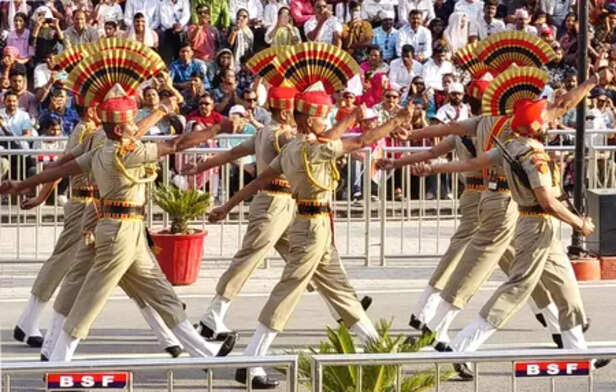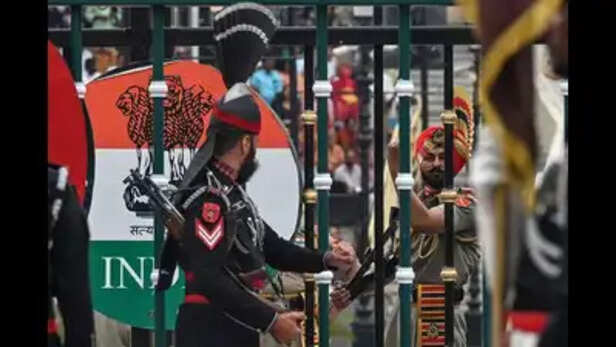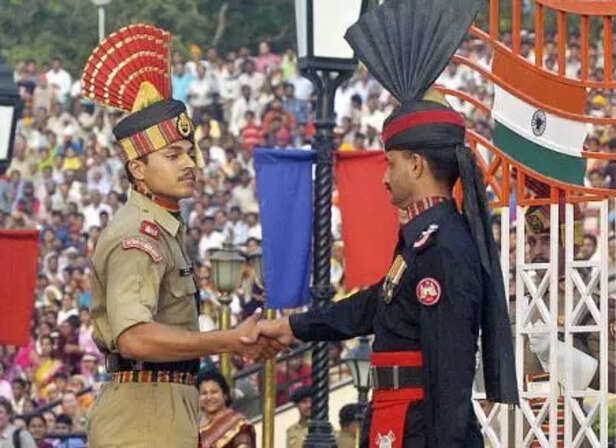Attari-Wagah Border Retreat Ceremony to Resume Today in a Restricted Manner – Is Everything Back to Normal or Just the Silence Before the Storm?
Ankit Gupta | May 20, 2025, 19:42 IST
For locals and tourists, the ceremony’s revival brings hope—of revived footfall, of economic lifelines. But for strategists and citizens watching closely, one question remains: Is this theatrical calm a show of strength, or simply the quiet that comes before another storm?
The sun will set today on the Attari-Wagah border with a familiar rhythm. Boots will stomp, flags will lower, and the echo of patriotism will ripple through the grandstands. After nearly two weeks of tense silence, the Border Security Force (BSF) is resuming the iconic Beating Retreat ceremony at India’s three main border outposts with Pakistan — Attari (Amritsar), Hussainiwala (Ferozepur), and Sadki (Fazilka).
But even as the spectacle returns, it will do so with an air of restraint, if not unease. Two long-standing elements — the symbolic handshake between the BSF and Pakistan Rangers, and the opening of border gates — will remain suspended due to what officials describe as “continuing security concerns” after Operation Sindhoor, India’s retaliatory strike on terror launch pads across the border.
The question that lingers in every mind:
Is this the return of normalcy — or merely a pause before another geopolitical flare-up?

First held in 1959, the Beating Retreat at Attari-Wagah has evolved into a daily performance of choreographed aggression and synchronised nationalism. Every evening, soldiers from both nations engage in a powerful show of pageantry — tall hats, exaggerated goose-steps, sharp salutes, and dramatic stares — culminating in the lowering of national flags.
For decades, the event has symbolised both competition and coexistence — an ironic duet of enmity and protocol played out on a daily basis. But in the aftermath of real bloodshed, like the April 22 terror attack in Pahalgam that killed 11 Indian personnel, the theatrics feel fragile.
On May 8, the BSF suspended public access to the ceremony as tensions peaked following India’s Operation Sindhoor, a precision air and ground offensive targeting terror camps in Pakistan-Occupied Kashmir and across the international border.

The reopening of the ceremony is expected to bring immediate relief to border tourism-dependent economies, particularly in Amritsar and Ferozepur. Guesthouses, dhabas, rickshaw pullers, and handicraft sellers — all had seen sharp declines in income during the suspension. “The retreat ceremony is our lifeline,” says Jaspreet Singh, a rickshaw operator outside the Attari viewing gallery. “When it stopped, it was like the heart of our town stopped beating.”
However, the revival does not mean a return to previous norms. The handshake between BSF jawans and Pakistani Rangers, usually greeted by applause from the stands, has been scrapped for now. “It’s not business as usual,” said a BSF officer on condition of anonymity. “The risk of symbolic gestures being seen as diplomatic weakness is too high after what happened in Pahalgam and Sindhoor.”
Indeed, sources within the Home Ministry confirm that intelligence agencies have advised restraint in cross-border civilian interactions, especially in light of increased infiltration alerts and fresh movement along the Line of Control.

Operation Sindhoor — launched in early May — was India’s most high-profile retaliatory strike since the 2019 Balakot operation. While details remain classified, defence sources indicate that several high-value terror assets were neutralised in Neelum Valley, Kotli, and Sharda sectors. These locations, said to host Pakistan-backed militant infrastructure, had reportedly been used to plan and orchestrate the Pahalgam suicide attack, which claimed the lives of 11 Indian security personnel and injured over two dozen.
While India publicly justified the operation as a “measured response” to unprovoked provocation, Pakistan’s Foreign Office condemned it as “an act of aggression.” Global reaction remained muted, though several Western capitals privately acknowledged India’s “right to self-defence.”
That muted international response has given India diplomatic space. But it has also added weight to India’s caution in resuming border diplomacy. “The signal is clear: India wants to show resolve without inviting escalation,” says Lt Gen (Retd.) S.L. Narayanan, a former Army Corps Commander. “Hence the retreat resumes, but the handshake doesn't.”

In diplomacy, optics often precede substance. Resuming the retreat, while withholding the handshake, allows India to project control without capitulation.
“The Beating Retreat is theatre, yes, but also signalling,” says Ambassador Ashok Kantha, former envoy to China. “It’s a delicate dance — show strength without appearing warm, show openness without being vulnerable.”
Interestingly, Indian authorities have ramped up surveillance and scanning protocols at all three venues. Drone monitoring, facial recognition systems, and AI-assisted crowd tracking have been quietly introduced under the new SOPs issued post-May 8.
On the Pakistani side of the border, too, public ceremonies have resumed, but with similar restraint. Pakistani Rangers have maintained presence during rehearsals but have reportedly been ordered to avoid “extended engagement or verbal exchanges” with BSF personnel.
Local Pakistani media has been low-key in its coverage of both the Pahalgam attack and Operation Sindhoor, suggesting a strategy of narrative minimisation. “It’s in their interest to de-escalate publicly, even if they remain defiant internally,” notes Ayesha Jalal, South Asia historian based in the U.S.
As the flags descend at sunset today, claps will rise, slogans will thunder, and tourists will cheer. But those in uniform know that the ground beneath remains volatile. The ritual continues, but the trust doesn’t.
For the time being, the Beating Retreat is back. But in the charged geography of India and Pakistan, such symbols are not mere routines. They are masks — sometimes worn for the world, sometimes for oneself.
Whether today’s resumed ceremony marks the calm after the storm, or merely the lull before another one, remains to be seen.
But even as the spectacle returns, it will do so with an air of restraint, if not unease. Two long-standing elements — the symbolic handshake between the BSF and Pakistan Rangers, and the opening of border gates — will remain suspended due to what officials describe as “continuing security concerns” after Operation Sindhoor, India’s retaliatory strike on terror launch pads across the border.
The question that lingers in every mind:
Is this the return of normalcy — or merely a pause before another geopolitical flare-up?
A Ceremony Rooted in Ritual and Rivalry

Low-key Beating Retreat ceremony at 3 India-Pak border points in Punjab resumes today
( Image credit : IANS )
First held in 1959, the Beating Retreat at Attari-Wagah has evolved into a daily performance of choreographed aggression and synchronised nationalism. Every evening, soldiers from both nations engage in a powerful show of pageantry — tall hats, exaggerated goose-steps, sharp salutes, and dramatic stares — culminating in the lowering of national flags.
For decades, the event has symbolised both competition and coexistence — an ironic duet of enmity and protocol played out on a daily basis. But in the aftermath of real bloodshed, like the April 22 terror attack in Pahalgam that killed 11 Indian personnel, the theatrics feel fragile.
On May 8, the BSF suspended public access to the ceremony as tensions peaked following India’s Operation Sindhoor, a precision air and ground offensive targeting terror camps in Pakistan-Occupied Kashmir and across the international border.
Tourism Reopens, But Trust Remains Closed

Image Credit: TOI
The reopening of the ceremony is expected to bring immediate relief to border tourism-dependent economies, particularly in Amritsar and Ferozepur. Guesthouses, dhabas, rickshaw pullers, and handicraft sellers — all had seen sharp declines in income during the suspension. “The retreat ceremony is our lifeline,” says Jaspreet Singh, a rickshaw operator outside the Attari viewing gallery. “When it stopped, it was like the heart of our town stopped beating.”
However, the revival does not mean a return to previous norms. The handshake between BSF jawans and Pakistani Rangers, usually greeted by applause from the stands, has been scrapped for now. “It’s not business as usual,” said a BSF officer on condition of anonymity. “The risk of symbolic gestures being seen as diplomatic weakness is too high after what happened in Pahalgam and Sindhoor.”
Indeed, sources within the Home Ministry confirm that intelligence agencies have advised restraint in cross-border civilian interactions, especially in light of increased infiltration alerts and fresh movement along the Line of Control.
Operation Sindhoor

The Context Behind the Curtain
Operation Sindhoor — launched in early May — was India’s most high-profile retaliatory strike since the 2019 Balakot operation. While details remain classified, defence sources indicate that several high-value terror assets were neutralised in Neelum Valley, Kotli, and Sharda sectors. These locations, said to host Pakistan-backed militant infrastructure, had reportedly been used to plan and orchestrate the Pahalgam suicide attack, which claimed the lives of 11 Indian security personnel and injured over two dozen.
While India publicly justified the operation as a “measured response” to unprovoked provocation, Pakistan’s Foreign Office condemned it as “an act of aggression.” Global reaction remained muted, though several Western capitals privately acknowledged India’s “right to self-defence.”
That muted international response has given India diplomatic space. But it has also added weight to India’s caution in resuming border diplomacy. “The signal is clear: India wants to show resolve without inviting escalation,” says Lt Gen (Retd.) S.L. Narayanan, a former Army Corps Commander. “Hence the retreat resumes, but the handshake doesn't.”
A Diplomatic Game of Appearances

No handshake, gate opening at Attari border during beating retreat ceremony
In diplomacy, optics often precede substance. Resuming the retreat, while withholding the handshake, allows India to project control without capitulation.
“The Beating Retreat is theatre, yes, but also signalling,” says Ambassador Ashok Kantha, former envoy to China. “It’s a delicate dance — show strength without appearing warm, show openness without being vulnerable.”
Interestingly, Indian authorities have ramped up surveillance and scanning protocols at all three venues. Drone monitoring, facial recognition systems, and AI-assisted crowd tracking have been quietly introduced under the new SOPs issued post-May 8.
The View from the Other Side
Local Pakistani media has been low-key in its coverage of both the Pahalgam attack and Operation Sindhoor, suggesting a strategy of narrative minimisation. “It’s in their interest to de-escalate publicly, even if they remain defiant internally,” notes Ayesha Jalal, South Asia historian based in the U.S.
Back to Normal — Or a New Normal?
For the time being, the Beating Retreat is back. But in the charged geography of India and Pakistan, such symbols are not mere routines. They are masks — sometimes worn for the world, sometimes for oneself.
Whether today’s resumed ceremony marks the calm after the storm, or merely the lull before another one, remains to be seen.
What Has Changed in the Beating Retreat Ceremony Post-Operation Sindhoor?
- No Handshake: The customary handshake between Indian BSF and Pakistani Rangers remains suspended indefinitely.
- Gates Stay Shut: The Wagah border gates will not open during the ceremony, breaking from the tradition.
- Increased Surveillance: Drone-based monitoring and facial recognition introduced for crowd security.
- Reduced Visitor Capacity: Only 70% seating capacity allowed as a precautionary measure.
- Shortened Duration: The ceremony will be approximately 5 minutes shorter, excluding certain theatrical elements.
